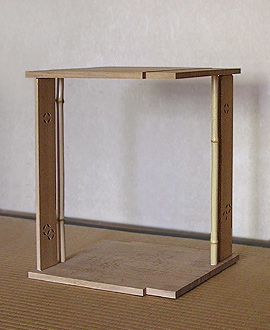|
||
 |
||
When a single hanging shelf is used in a small kitchen, mizuya, it is extended to 35-36cm long. If the tea ceremony room is arranged with the firebox placed inside the host's mat *temaedatami _Oô, the shelf is constructed along the right inner edge of the furnace *mukogiri üØ. If a middle post *nakabashira , is included in the room, the shelf is hung toward the guest's mat *kyakudatami qô. Lacking the middle post the shelf may be hung in the kitchen. When the shelf is hung in the tea ceremony room, its position must be within easy reach of the host because it is used for arranging the tea utensils. Examples: Myoukian Taian ìÁÒÁ, Saiouin, Yodomi-no-seki ¼¥@ÅÌÈ both in Kyoto; Kanden'an cÁ in Shimane prefecture..

@
(C)2001 Japanese Architecture and Art Net Users System.@No reproduction or republication without written permission.
fÚÌeLXgEÊ^ECXgÈÇASÄÌRec̳f¡»E]ÚðֶܷB

